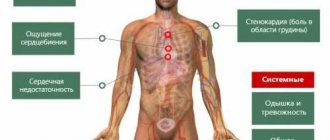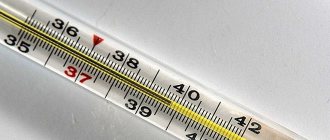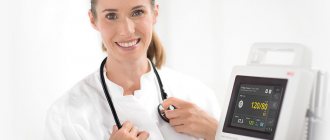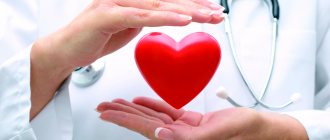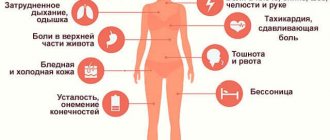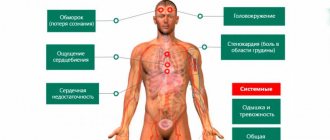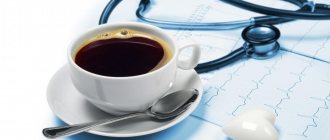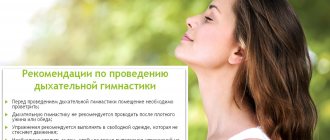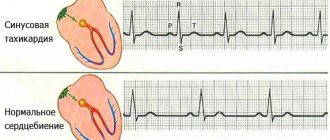Physiological mechanism
An increase in temperature most often indicates the progression of the inflammatory reaction. In rare cases, a fever of a neurogenic nature appears, which occurs as a result of trauma to certain structures of the brain.
Against the background of the proliferation of infectious pathogens, the production of protective antibodies and biologically active substances—inflammatory mediators—occurs. Bacterial waste products also cause an inflammatory response. Against this background, the thermoregulation center is stimulated, which is responsible for temperature changes.
The intensity of the fever depends on the conditions that led to the inflammatory response and increased heart rate. An increase in temperature itself can increase the load on the cardiovascular system and cause tachycardia.
Actions in case of such violation
When, during a cold, a person experiences an increase in heart rate and rapid work of the heart muscle, there is no need to panic. It is necessary to observe complete bed rest and also drink enough fluids during the day. Do not forget about taking antipyretic drugs. Such medications can not only defeat the infectious agent, but also normalize temperature indicators.
If rapid heartbeat during a cold occurs against a background of normal temperature, then antipyretics are replaced with antiviral drugs. They destroy pathogenic bacteria and block the development of the infectious process. Additionally assigned:
- vasoconstrictor medications;
- antioxidants that improve blood circulation in the body;
- cardiac glycosides;
- beta blockers to reduce stress.
Also, during treatment you should adjust your menu. You should avoid fatty and spicy foods, as well as drinks that contain caffeine. It is imperative to take complexes that strengthen the immune system. Provide your body with a good night's rest, which should last at least eight hours.
You should engage in moderate exercise throughout the day. This will not only normalize the functioning of the heart muscle, but will also increase the body’s resistance to pathogenic bacteria. Another important point for a cold that occurs with the onset of a feverish state is sufficient compliance with the drinking regime. Against the background of dehydration, the volume of blood flow decreases, as a result of which the cardiovascular system works in an enhanced mode. Drinking plenty of fluids when you have a cold will help reduce the risk of heart palpitations.
Etiological factors
Rapid heartbeat during elevated temperature in adults and children appears mainly against the background of infectious diseases:
- ARVI;
- Sore throat, otitis and other ENT pathologies;
- Pneumonia;
- Infectious and inflammatory processes of the genitourinary organs;
- Formation of abscesses.
Particular attention should be paid to conditions in which the temperature remains high, above 38-39 degrees, for a long time. In this case, you need to contact a specialist who will conduct a comprehensive diagnosis and be able to understand why fever and tachycardia appear at a temperature.
If your child has a strong heartbeat and fever
Strong heartbeat at elevated temperatures in a child usually does not pose a danger if there is no heart disease (myocarditis, defect, congenital rhythm disturbances). In such cases, normalization of the rhythm occurs independently as the general condition improves. It is necessary to provide:
- bed rest;
- a gentle diet, predominantly dairy-vegetable, there is no need to force-feed, it is better not to give whole milk, it is poorly digested during fever;
- a gradual decrease in temperature (over 38 degrees), it is not necessary to immediately strive for 36.5 degrees, it is enough to reduce by 0.5-0.7 degrees, for this you can wipe with a napkin soaked in water at room temperature, apply cold to the armpits, groin area for 2-3 minutes.
Antipyretics (Nurofen, Panadol) are given in the usual age-specific dose; Analgin, Aspirin and potent drugs (for example, Nimesulide) are not recommended. In case of severe pallor of the skin, they are supplemented with No-Shpa or Dibazol (as prescribed by a doctor). Sometimes the introduction of antiallergic drugs (Suprastin, Tavegil) is required.
If, during such treatment, the child’s condition worsens, lethargy, nausea, vomiting occurs, and the temperature does not decrease, then an ambulance must be called and therapy in a hospital setting.
The pulse accelerates at elevated temperatures, the normalization of indicators is interconnected - after eliminating intoxication and fever, heart rhythms are restored. A reduction with drugs is necessary for any increase for patients with cardiac pathology; for others, bed rest and plenty of fluids are sufficient.
Temperature with vegetative-vascular dystonia
Vegetovascular dystonia (VSD) has various clinical manifestations, among which hyperthermia is often found. Many people don't even notice a low-grade fever. It most often occurs with vegetative-vascular dystonia in adolescents and young adults.
Changes in temperature are associated with impaired thermoregulation. The hypothalamus is responsible for this process, and in most cases, experts do not detect any serious deviations in health.
Manifestations of vegetative-vascular dystonia disappear on their own after normalization of lifestyle, sleep and rest patterns, restoration of normal hormonal levels and functioning of the nervous system.
The hypothalamus sends specific signals to the thermoregulation center when the symptoms of vegetative-vascular dystonia worsen, and the pressure often increases and fear arises.
Typically, the temperature during VSD increases slightly and remains at the level of low-grade fever.
If additional headaches, dizziness, physical weakness, or decreased immunity appear, an examination is necessary.
Temperature 37 tachycardia
Symptoms: prolonged elevated temperature, temperature 37, progressive increase in body temperature, rapid heartbeat, clouding, loss of consciousness, nausea, weakness, convulsions, heaviness in the head, headache, feeling of heat, feeling of cold, chills, excruciating thirst, increased nervous excitability, irritability, neurosis, hallucinations, pale skin, redness of the skin, insomnia, shortness of breath, excessive sweating, chest pain, abdominal pain.
Low-grade fever is an elevated body temperature that lasts for a long period of time. In diseases of the autonomic nervous system, this temperature can last for months and years, and the amplitude of its fluctuations usually does not exceed 37 - 37.8 degrees.
As a rule, elevated body temperature reflects some kind of inflammatory process inside the body, caused by infections, parasites, allergens, or even oncology.
The cause of low-grade fever in adults is often sought in diseases of the thyroid gland (hyperthyroidism), and in children - in inflammation of the tonsils.
However, it also happens that numerous clinical studies do not reveal any pathologies, and the removal of tonsils does not lead to normalization of body temperature. Then it makes sense to talk about problems in the functioning of the autonomic nervous system.
In our practice, this symptom occurs very often. It is associated with dysfunction of thermoregulation, one of the main functions of the autonomic nervous system. Actually, it is precisely thanks to this function of this part of the nervous system that we are able to observe on a thermogram (thermal imaging study) disturbances in one or another vegetative node.
Low-grade fever may be accompanied by general malaise, wave-like manifestations of increased sweating, feelings of heat or cold, chills and other symptoms that usually accompany elevated body temperature or a general disorder of the autonomic nervous system (headache, rapid heartbeat, etc.).
Cases from practice
Woman, 21 years old, student.
In December 2013, a young girl came to the clinic. For the last few months, my body temperature has constantly remained at 37.2-37.5.
The physique is asthenic, the skin is pale, with excessive sweating, from time to time I felt hot. At times, the symptoms were accompanied by increased irritability and anxiety.
I experienced headaches several times a week. I often experienced general weakness, melancholy, and dizziness.
First, the patient turned to a therapist, who prescribed her a series of examinations: general and biochemical analysis of urine and blood, X-ray of the lungs, ultrasound of internal organs, etc. The causes of the elevated temperature could not be identified.
The doctor said that this was primary hyperthermia against the background of vegetative dystonia, that this was normal and would go away with age.
You need to gain a little weight, walk more in the fresh air, relax, do physical exercise, you can take vitamins.
In this state, studying and working became more and more problematic: it was “difficult to understand,” I was constantly thirsty and, as a result, had to go to the toilet, and often needed to leave the room and go out into the fresh air. The girl’s parents were looking for options to alleviate this diagnosis and came to our clinic.
The autonomic disorder arose due to a stressful lifestyle and mild traumatic brain injury at the age of 14 years.
After two courses of treatment, the girl completely recovered.
Woman, 25 years old.
A young girl contacted us in 2020. Since February 2014, she began to experience panic attacks (vegetative crises).
Read also: Reciprocal supraventricular tachycardia
About a year before the first attack of inexplicable fear, the girl underwent surgery under general anesthesia.
Immediately after this, symptoms such as sleep disturbance and increased anxiety began to appear.
In addition, under severe psycho-emotional stress (“overexcited”), the girl’s temperature rose to 37.5 degrees and could last for several hours.
The patient's general condition was characterized by constant anxiety and chills. The extremities were usually cold. I was worried about the heaviness in the neck area.
She underwent one course of treatment at the Clinical Center for Autonomic Neurology. Already during treatment, panic attacks stopped bothering me. Soon the patient noted a steady improvement in her condition. A month after the course, I felt completely healthy.
Temperature 37 5 and tachycardia
Source: https://starlab-mdc.ru/bolezni-serdtsa/tahikardiya/temperatura-37-tahikardiya.html
Diagnostics
Tachycardia at a temperature is an indication for contacting a cardiologist or therapist first. Using laboratory diagnostics, it is possible to identify changes in blood and urine tests corresponding to an infectious-inflammatory process. PCR, ELISA makes it possible to determine the nature of hyperthermia in combination with tachycardia.
Additional diagnostic methods:
- Ultrasound of internal organs;
- ECG;
- 24-hour Holter ECG monitoring;
- MRI of the heart;
- EchoCG;
- Electrophysiological study of the heart;
- Determination of the level of thyroid-stimulating hormones in the blood;
- EEG of the brain.
Specific methods for diagnosing vegetative-vascular dystonia at body temperature should be selected by the attending physician.
You may need to consult other specialized specialists, including an endocrinologist, neurologist, and psychotherapist.
Why do you worry about a rapid heartbeat when you have a cold?
Every person in the world has experienced colds. And it’s no secret that their symptoms cause a lot of discomfort and discomfort.
If you do not start fighting the disease in time, complications may arise in the form of headaches, sinusitis and even tachycardia.
In the latter case, this is an increased or rapid heartbeat during a cold, which can either disappear when the necessary treatment appears, or, on the contrary, develop into more serious cardiovascular diseases.
Why does it happen?
The causes of rapid heartbeat during colds are still not fully understood, because such a symptom is one of the forms of complications in the functioning of the heart and blood vessels.
An increased heart rate during a cold is accompanied by an increase in heart rate. The reasons for increased heart rate may be some features of a cold.
Let's look at them in more detail.
Fever
In most cases, ARVI is accompanied by an increase in body temperature, on which the proper functioning of the cardiovascular system directly depends.
It is worth noting that each added degree of temperature speeds up the heart rate by 10 beats per minute. This unique feature accelerates the movement of protective immune antibodies to the site where the virus was formed.
An increased heart rate allows you to remove toxins from the body much faster.
When a cold is accompanied by purulent processes, the pulse can rise much higher and faster. However, do not worry if your heart rate is 110 beats per minute, because this is quite normal.
Dehydration
Doctors strongly recommend drinking plenty of fluids during colds, because body temperature rises and sweating occurs, which releases harmful microorganisms.
If there is little fluid in the body, there is less blood in the vessels and its viscosity increases.
To ensure normal blood flow to all organs, an accelerated heartbeat appears during a cold, so that it is possible to disperse blood throughout the body, as before.
In this case, tachycardia is characterized by an increased heartbeat rather than an accelerated one, which leads to a decrease in pressure in the arteries, and dehydration can lead to more dire consequences.
Caffeine overdose
When talking about drinking plenty of fluids during colds, it is worth understanding that the patient drinks a lot of liquid, especially hot liquid. As a rule, heavy drinking consists of hot tea and even coffee, which contain caffeine. In the case of tea, the dose is small, but it can also lead to increased heart rate.
Possible complications
In addition to the above reasons, other reasons can provoke the appearance of tachycardia.
For example, some pathogenic microorganisms penetrate the internal organs and the heart is no exception.
Their vital activity leads to a malfunction of the organ, which causes rapid heartbeat during a cold. When the heart muscle becomes inflamed, a person experiences the following symptoms:
- increased heart rate;
- increased body temperature;
- stitching pain in the region of the heart;
- body aches;
- chills;
- fatigue and weakness.
In addition, some other diseases may worsen. Increased blood pressure and tachycardia can be caused by hypertension. In this case, it is necessary to take antipyretics and drugs that reduce blood pressure.
Diagnostics
When visiting a doctor if palpitations occur against the background of progression of ARVI, the doctor must carry out diagnostic measures aimed at identifying possible diseases of the heart and vascular system. The activities are as follows:
- Laboratory tests - urine and general blood test. This method allows you to detect a viral infection that could cause an increase in the number of pulse beats. Using a blood test, you can also identify other blood diseases that are in no way related to pathogenic microorganisms.
- Magnetic resonance imaging - involves taking pictures of the brain, based on the results of which the doctor can assess the condition of the blood vessels. In addition, it is possible to identify problems in the central nervous system. The heart muscle is also examined if the cold does not go away for a long time.
- An ECG is a way to determine the degree and type of work of the heart muscle. This method is the most popular and has high accuracy of results.
Treatment
To get rid of an irregular heart rhythm during ARVI, you need to destroy the root cause of the cold, i.e. the virus that caused the inflammation. For effective treatment of colds it is recommended:
- compliance with bed rest;
- at elevated body temperature (more than 38.5 degrees), antipyretic medications should be taken;
- abundant fluid intake - it is best to replace standard coffee and tea with medicinal decoctions and teas, hot fruit drinks and compotes, and it is also advisable to include warm milk with honey in the diet;
- antiviral drugs to fight infection;
- fight against cough - take medications strictly as prescribed by the doctor, who determines the nature of the cough;
- gargling with a decoction of calendula and chamomile, but you can also use a saline solution;
- drugs for constricting blood vessels against a runny nose (as prescribed by the attending physician).
Prevention of tachycardia during ARVI
If you still did not protect yourself and are faced with a cold, then be careful so that it does not lead to the appearance of tachycardia. To do this, you should follow some simple rules:
- stop smoking and alcohol;
- remove spicy and fatty foods from your diet;
- exclude strong tea and coffee;
- Reduce the strain on your heart by limiting physical activity, including sports.
ontakteWhatsApp in Symptoms
Symptoms: prolonged elevated temperature, temperature 37, progressive increase in body temperature, rapid heartbeat, clouding, loss of consciousness, nausea, weakness, convulsions, heaviness in the head, headache, feeling of heat, feeling of cold, chills, excruciating thirst, increased nervous excitability, irritability, neurosis, hallucinations, pale skin, redness of the skin, insomnia, shortness of breath, excessive sweating, chest pain, abdominal pain.
Low-grade fever is an elevated body temperature that lasts for a long period of time. In diseases of the autonomic nervous system, this temperature can last for months and years, and the amplitude of its fluctuations usually does not exceed 37 - 37.8 degrees.
As a rule, elevated body temperature reflects some kind of inflammatory process inside the body, caused by infections, parasites, allergens, or even oncology. The cause of low-grade fever in adults is often sought in diseases of the thyroid gland (hyperthyroidism), and in children - in inflammation of the tonsils. However, it also happens that numerous clinical studies do not reveal any pathologies, and the removal of tonsils does not lead to normalization of body temperature. Then it makes sense to talk about problems in the functioning of the autonomic nervous system.
In our practice, this symptom occurs very often. It is associated with dysfunction of thermoregulation, one of the main functions of the autonomic nervous system. Actually, it is precisely thanks to this function of this part of the nervous system that we are able to observe on a thermogram (thermal imaging study) disturbances in one or another vegetative node.
Low-grade fever may be accompanied by general malaise, wave-like manifestations of increased sweating, feelings of heat or cold, chills and other symptoms that usually accompany elevated body temperature or a general disorder of the autonomic nervous system (headache, rapid heartbeat, etc.).
Tachycardia with increased temperature in children
Children have a higher heart rate than adults. This must be taken into account when identifying possible tachycardia. The pulse of a child in the first months of life can be above 130-150 beats per minute. In an adult, a pulse of up to 90 is considered normal.
As body temperature rises, the load on the heart increases. This leads to a natural increase in heart rate. This pattern is most noticeable in newborns, in whom, with hyperthermia, the rate can reach 170 beats per minute.
Physiological tachycardia in children with rising temperature is associated with the following changes in the body:
- Dehydration, especially against the background of intestinal infections, which are accompanied by fever, diarrhea, and intoxication syndrome;
- Physical exercise;
- Overheating of the body due to prolonged exposure to direct sunlight or due to the use of clothes that are too warm and inappropriate for weather conditions;
- The use of certain medications, including adrenaline;
- Severe pain syndrome.
It can be difficult for parents to distinguish physiological from pathological tachycardia during an increase in body temperature. Therefore, if signs of fever appear, you should immediately contact a specialist or call a doctor at home.
Tachycardia is especially dangerous, which does not disappear after taking antipyretics and normalizing the temperature.
What to do with tachycardia and temperature 37-38 in an adult
If tachycardia at a temperature of 37-38 degrees does not cause much discomfort, then it is enough to provide the patient with complete physical and psychological rest, access to fresh air, and a comfortable room temperature. Drinking acidified drinking water, fruit drink, and diluted juice helps, as the blood is cleansed of toxins faster.
When the rhythm increases to 120-130 beats per minute or above 90 in heart patients and hypertensive patients, it is necessary to reduce even a slightly elevated temperature. Take Paracetamol, Ibuprofen, Nimesil. It is also important to monitor blood pressure and, if necessary, reduce elevated levels (for example, Capoten, Enalapril). To slow down the pulse, you can use hawthorn tincture, lily of the valley-valerian drops, Valocordin.
Possible symptoms
An increased heart rate at a temperature is accompanied by symptoms of the underlying disease. Fever usually causes headaches and muscle pain, which indicate that toxins have entered the bloodstream and the progression of a protective inflammatory response.
Possible additional symptoms:
- Physical weakness, decreased performance;
- Dizziness;
- Runny nose;
- A sore throat;
- Deterioration in the quality of nasal breathing;
- Decreased sleep;
- Psycho-emotional instability, irritability.
If the temperature rises due to infections of the genitourinary organs, characteristic pain appears in the lower abdomen and groin, and urinary function is impaired. With rotavirus infection, intestinal disorders associated with infectious pathogens, diarrhea, nausea and vomiting additionally occur.
The appearance of tachycardia at a temperature due to heart disease cannot be ruled out. They are usually accompanied by intense pain in the chest, shortness of breath, which intensifies with physical exertion, and characteristic bluish skin in the area of the nasolabial triangle.
Characteristic symptoms
With a high pulse rate, the heart loses its ability to supply blood to all parts of the body, which negatively affects the supply of organs and tissues with sufficient oxygen. This situation is accompanied by the following symptoms.
- In some cases, this may be a slight discomfort, in which the patient is not particularly concerned about the question of why his pulse is elevated and what to do.
- There is a rapid heartbeat, accompanied by clearly felt tremors in the chest area.
- There may be no painful sensations, but there is a feeling of anxiety and fear of such manifestations, especially at night. Such attacks do not last long, then the heart continues to work calmly. Frequent companions are dizziness, headache, hot flashes.
- A high pulse can be felt in several parts of the body. These symptoms frighten the patient very much and provoke insomnia and night terrors.
It should be remembered: if the pulse is constantly high, this is most likely due to pathological changes. They require immediate identification of the disease that contributes to the manifestation of the listed symptoms.
Treatment of tachycardia at temperature
Treatment of tachycardia during febrile conditions directly depends on the underlying disease. If palpitations are associated only with an increase in temperature, it is necessary to use modern antipyretics. They quickly solve the problem of hyperthermia in children and adults.
But fever in a child cannot be eliminated with common medications without first consulting a specialist. If the doctor cannot quickly examine the child, it is recommended to use antipyretics in syrup and suppositories, which can be used from the first days of life.
There are still age restrictions for such medications, so please read the instructions carefully before using a particular medication.
Specialists often prescribe non-steroidal anti-inflammatory drugs for tachycardia in combination with high body temperature, which help eliminate pain, relieve signs of intoxication and reduce body temperature.
If the temperature is caused by ARVI or ENT pathologies, antihistamines must be prescribed. They relieve swelling from mucous tissues and prevent breathing problems, including in children. It is important to take into account the fact that high temperature leads to dehydration of the body.
Hyperthermia is especially dangerous for young children. They must be given more fluids to drink throughout the entire period of illness.
In case of fever, it is necessary to maintain bed rest, avoid hypothermia and stress factors. If tachycardia in combination with hyperthermia occurs against the background of heart and vascular diseases, it is worth using certain drugs against arrhythmia, blood pressure and high cholesterol.
Symptomatic therapy may include the use of sedatives. They ease the course of vegetative-vascular dystonia, improve sleep, and relieve excessive nervous tension. For insomnia, sleeping pills can be used.
Some patients require the use of antidepressants and tranquilizers, especially with severe fear, psycho-emotional stress, and panic attacks.
Temperature and rapid heartbeat in a child - causes and methods of treatment
Tachycardia, that is, rapid heartbeat, can be a sign of serious pathology. However, the appearance of rapid heartbeat in a child with fever is of a different nature. Let’s consider all the manifestations of this pathology in detail and figure out in what cases you should worry about the baby’s health.
Bottom line
A rapid heartbeat in young children is a natural reaction to stimuli. The baby may be frightened of something or become very nervous, overheat in the sun or become overtired. Physiological tachycardia also occurs in adolescence, which is due to changes in the body.
However, physiological tachycardia must be distinguished from heart pathology. It usually manifests itself in sudden attacks and is always accompanied by an uneven heartbeat. Timely detection of pathology and active treatment will help the child become healthy.
Source: https://temperatura03.ru/simptomy/uchashhennoe-serdtsebienie-pri-temperature-u-rebenka.html
Tachycardia and sports
Tachycardia and elite sport are a rather dubious combination. Intense physical activity is contraindicated for any form of arrhythmia. But moderate activity, on the contrary, strengthens the cardiovascular system and increases the resistance of the myocardium to temporary lack of oxygen and stress.
But it is necessary to approach the choice of a sport with a tendency to tachycardia, in combination with hyperthermia, professionally and carefully. It is better to consult your doctor with this question. If your health worsens, training should be stopped for a while.
What sports can you do?
Tachycardia with a tendency to rise in temperature does not mean that you should completely abandon sports. Moderate loads are necessary. But what kind of sports can you do?
When choosing a suitable sports direction, consider the following factors:
- Diagnosis made;
- Age;
- General health;
- Weight;
- Heart rate level;
- Blood pressure numbers.
If tachycardia appears only when the temperature rises against the background of infectious diseases, then during the period of acute manifestations any physical activity is prohibited. You can return to sports training after recovery and restoration of good health.
With vegetative-vascular dystonia and a slight increase in body temperature, intensive training with heavy lifting and exercises that cause severe fatigue are prohibited. Particular attention to the choice of sport should be shown in the presence of concomitant cardiovascular pathologies.
Such diseases require strict monitoring of the level of physical activity and heart condition.
If you have high body weight, common sports are prohibited: running, cycling, jumping, lifting weights. Such exercises in obese people are several times greater than the load on the joints, especially the knees, which leads to their destruction.
If you have tachycardia, you can do jogging, swimming, dancing, yoga and other calm and relatively safe activities.
Cardio training
Cardio training, with proper control of the heart rate, can be considered a method of physical therapy. It is used even after a myocardial infarction, but only when the body has fully recovered.
Cardio training is practiced to strengthen the heart muscle. It is best to use modern simulators for this, which allow you to monitor pulse, blood pressure and other important indicators. Loads should be moderate so that the pulse does not rise above 130-140 beats per minute.
It is better not to use long exercises. For tachycardia, short-term exercise is recommended, lasting no more than 10-20 minutes.
Yoga and Pilates
Yoga and Pilates provide a static load on the body and are well suited for people with unstable heart function. It is important to gradually master a new sport.
Yoga is especially useful, as it allows you to achieve harmony between the physical and spiritual state, teaches proper breathing, increases resistance to stress, and normalizes sleep. During quiet activities, tissue trophism improves, including cells of the cardiovascular system.
Other types of physical activity for tachycardia
Even seemingly ordinary home exercises and simple walking can be considered as preventive exercises that strengthen the heart and increase the body's resistance to adverse external influences and stress.
Regular exercise allows you to control the course of hypertension, reduce the manifestations of this disease and even reduce the dose of antihypertensive drugs used. Sports also help to maintain weight, avoid the appearance of obesity and related endocrine pathologies.
The main principles of physical activity for tachycardia are:
- Careful selection of safe exercises;
- Regularity of training;
- Avoiding overwork;
- Refusal to exercise if your health worsens, your heart rate increases above 80-90 beats per minute at rest;
- Monitoring your heart rate during sports.
It is recommended to periodically visit your doctor to monitor the condition of the heart, blood vessels, and the course of chronic pathologies.
Remember the importance of following the principles of a healthy diet, which help to avoid atherosclerosis, stroke, heart attack and other dangerous but very common pathologies.
Rapid pulse
A rapid or high pulse is observed with increased work of the cardiovascular system. This can be either a compensatory reaction to increased load or a pathological phenomenon.
Most often, tachycardia during a cold is associated with the following diseases and conditions:
- Fever.
- Overdose of caffeine.
- Dehydration.
- Increased blood pressure.
- Diseases of the cardiovascular system.
An increase in temperature almost always accompanies colds, ARVI and flu. To cope with the infection, the immune system actively produces antibodies, which are carried throughout the body through the bloodstream and perform a protective function.
To achieve the maximum immune response, the cardiovascular system also works in an enhanced mode. The number of heartbeats increases and the pulse quickens. This causes the blood (and antibodies) to get to their destination faster.
In addition, increased blood circulation promotes the rapid elimination of breakdown products of bacteria or viruses, as well as their toxins. Thus, the body is detoxified.
The pulse rate directly depends on the height of the fever. On average, every degree increase in temperature increases your heart rate by 10 beats per minute.
The more severe the disease, the stronger the tachycardia. During purulent-inflammatory processes, the heart rate can reach significant numbers.
What to do if a person has a cold, has a runny nose, cough and increased heart rate? With a tachycardia of 100–110 beats per minute, there is no reason to panic. You need to stay in bed, drink enough fluids and, if necessary, use antipyretic drugs.
If there are risk factors - for example, coronary disease or heart defects - excessive tachycardia is undesirable. At the first sign of a cold, you should see a doctor.
Caffeine overdose
Anyone knows: “If we have a cold, we need to drink more.” And following this rule, he begins to drink strong tea in large quantities, periodically alternating it with coffee.
This results in a significant amount of caffeine entering the body.
This alkaloid stimulates not only the central nervous system, but also the cardiovascular system, causing tachycardia and an increase in blood pressure. Combined with an increased heart rate due to a fever, this can negatively affect your heart function and overall health.
Physiological tachycardia
The heart can beat fast for many reasons, such as:
- elevated temperature;
- physical stress;
- too hot air;
- taking certain medications;
- painful sensations.
An increase in heart rate and temperature in a child is a natural reaction of the body to illness. This condition is not considered a pathology and goes away with healing. In case of colds and other diseases, the body increases body temperature to expel germs and viruses: that is, it creates unfavorable conditions for them.
What happens when the body temperature rises? The immune system works in “combat mode”, blood flow and heart rate increase, as the task is to expel foreign elements from body tissues. At the same time, the pulse and heart rate naturally increase.
Table of increased heart rate at temperature:
- 1-2 months: from 154 to 194;
- 6 months: from 148 to 187;
- 1 year: from 137 to 176;
- 2 years: from 125 to 159;
- 3 years: from 120 to 152;
- 4 years: from 115 to 145;
- 5 years: from 110 to 139;
- 6 years: from 105 to 131;
- 7 years: from 99 to 125;
- 8-9 years: from 95 to 119;
- 10-11 years: from 95 to 117;
- 12-13 years: from 90 to 114;
- 14-15 years old: from 86 to 108.
Why and how the pulse changes with temperature
The pulse usually accelerates with temperature - an increase of one degree increases the heart rate by 8-10 in an adult and by 10-15 in a child. This is explained by a change in the nervous regulation of rhythm and a direct effect on the sinus node. To normalize, you need to reduce the temperature; if this fails, and against the background of tachycardia, pain in the heart or fainting occurs, then emergency medical help should be called.
Pathological tachycardia in a child
If, after the temperature drops from 39.2 or 38.5 to 36-37, the rapid heartbeat and pulse do not return to normal, then this indicates that:
- the body is not able to cope with the toxins of viruses or bacteria, and complications may develop;
- the child has some kind of heart disease;
- the infection led to the development of myocarditis, or the child had this disease even before the fever.
Therefore, after the temperature drops, it is important to check what the child’s pulse is and whether it has returned to standard values. If not, then you need to contact a cardiologist. You especially need to hurry up with this if the pulse is uneven and interruptions or stops are felt in the heartbeat.
Tachycardia may be a symptom of the following diseases or conditions:
- pathological dehydration, or dehydration;
- obesity;
- heart defects;
- neurocirculatory or vegetative-vascular dystonia;
- cardiopathy - the development of pathological changes in the heart muscle;
- thyroid disease associated with increased secretion - thyrotoxicosis;
- anemia (anemia).
In addition to the readings of a thermometer and tonometer, the following signs may indicate that a cold with a temperature of 38.7 or 39.5 has been accompanied by a heart or other serious illness that causes tachycardia:
- the child is very pale;
- pain appeared in the chest area;
- the veins in the neck are swollen;
- sticky cold sweat appeared on the skin;
- shortness of breath appeared;
- the child is feeling sick;
- fainting or a similar state.
If any of these symptoms appear, you should urgently call an ambulance. In this case, there is no need to give medications yourself, including antipyretics - it can make things worse. Need to:
- provide access to fresh air;
- Place a damp towel on your forehead and neck.
We see that an increased pulse in a child at a high temperature can be either a normal reaction to external or internal factors, or a sign of a serious illness. A timely visit to a pediatrician and, if necessary, to a pediatric cardiologist will help dispel all doubts about this.
First aid for a child
Heart attacks are not only common in adults; they also occur in children. Before the doctor arrives, you need to help the child and alleviate his condition:
- take it to fresh air or open a window;
- Place a towel wrung out from the water on your neck and forehead.
Important! You should not give your child medications: it is dangerous. Treatment can only be prescribed by a doctor.
Can heart disease in a child be cured? If the pathology is detected in time, the treatment outcome is positive in many cases. The baby will be prescribed a course of therapy, medication and exercises. In case of serious pathology, surgical treatment is necessary.
Pediatric tachycardia of a pathological nature is a serious reason to consult a doctor. Untreated pathology can result in serious complications that can lead to disability.
What heart rate is considered normal with and without fever?
Heart rate standards in children, both in a healthy state and during fever, differ from those in adults. It's connected with:
- smaller body size - the smaller the body, the faster the pulse;
- with the peculiarities of metabolism and hormonal levels during the period of active development and growth.
For an adult weighing 70 kg, a normal resting pulse is considered to be 70-75 beats per minute, and for a newborn weighing 3.5 kg - 159. Let's look at this indicator for children in age dynamics.
Pulse values in children of different ages are normal and at a temperature of 38-39
| Age | Normal heart rate at 36.6, beats per minute | Values at febrile temperature (physiological tachycardia) |
| From 30 days to a year | 110-170 | 0-60 days – 154-194; six months – 148-187; 11-12 months – 137-176. |
| At 1-2 years | 94-125 | From 137-176 at 1 year to 125-159 at 2 years. |
| At 2 years and up to 4 years | 90-125 | From 125-159 at 2 years, 120-152 at 3 years; 115-145 at 4 years. |
| At 4-6 years old | 85-120 | From 115-145 at 4 years, 110-139 at 5 and up to 105-131 at 6 years. |
| At 6 years old and up to 8 | 78-120 | From 105-130 at 6 years, 99-125 at 7, 95-119 at 8. |
| At 8-10 years old | 68-106 | 95-119 at 8-9 years old, 95-117 at 10. |
| At 10-12 years old | 60-100 | 95-117 at 10-11, 90-114 at 12 |
| At 12-15 years old | 55-95 | 90-114 at 12-13 years old, 86-108 at 14-15. |
And only from the age of 16 are heart rate norms compared with adults and are within the range of 65-90 beats per minute. Significant differences in values are explained by the fact that the heart rate is determined to a greater extent not by age, but by:
- weight, which can vary by half in children of the same age;
- body type: asthenic, normosthenic or hypersthenic;
- physical development, which in a sports child can be very different from that of his peers.
The cause of physiological tachycardia can be not only temperature, but also:
- physical exercise;
- dehydration;
- overheating due to too warm clothes or high room temperature;
- the effect of medications: solbutamol, drugs with adrenaline, aminophylline, atropine;
- pain.
We see from the table that a pulse of 125-130 for children under 6 years old at a temperature of 38 or 39 still falls within the normal range. An accelerated heartbeat is one of the body’s normal reactions to many diseases or injuries, a sign of putting all systems on “combat readiness” in order to cope with germs and other negative factors. After recovery, such tachycardia should go away.
If a rapid pulse was associated with overheating or physical exertion, then after eliminating the effects of these factors, it should also return to normal. In adolescents aged 10-15 years, a high pulse can be associated with hormonal surges in the process of physiological restructuring of the body. This is normal and does not require any intervention if it goes away quickly enough.
An increased heart rate in a child at a temperature of 38-39 – when is this normal and when is it not?
Temperature and rapid pulse
The number of pulse beats per unit time is equal to the number of heartbeats over the same range. Therefore, a child’s pulse is an important indicator of normal heart function or any pathological abnormalities. At a temperature of 38, the pulse is naturally increased, at 39 it becomes even higher. This is called physiological tachycardia.
But such an increase is considered normal only with moderate deviations and maintaining uniformity. If the pulse is uneven, measurements on an electronic blood pressure monitor show rhythm disturbances, then this may be a sign of heart disease.
Causes and types of tachycardia
There can be many factors causing pathology. It is divided into two types. Tachycardia is a sign of some diseases, and physiological tachycardia appears for natural reasons - due to excessive stress or strong emotions. If the heartbeat is irregular, this is a manifestation of atrial fibrillation, which is very dangerous to health and can lead to cardiac arrest.
Rapid heartbeat in children
In children under one year of age, blood pressure is slightly increased and the normal level is 130-160 beats per minute. Up to 2 years of age, a rapid pulse is considered normal at values from 120 to 150 beats/min. At the age of 15, the child’s pulse should be between 70 and 80 beats/min. A rapid heartbeat in children is a normal reaction of a rapidly growing body. The vessels are still small, but the need for blood supply is high, so the heart rate increases. However, it may have other reasons:
- stress;
- disturbances in the functioning of the endocrine system;
- improper development of the cardiovascular system;
- excessive exercise at home;
- side effects of medications;
- complications after illness.
What heart rate is considered normal with and without fever?
Heart rate standards in children, both in a healthy state and during fever, differ from those in adults. It's connected with:
- smaller body size - the smaller the body, the faster the pulse;
- with the peculiarities of metabolism and hormonal levels during the period of active development and growth.
For an adult weighing 70 kg, a normal resting pulse is considered to be 70-75 beats per minute, and for a newborn weighing 3.5 kg - 159. Let's look at this indicator for children in age dynamics.
Pulse values in children of different ages are normal and at a temperature of 38-39
| Age | Normal heart rate at 36.6, beats per minute | Values at febrile temperature (physiological tachycardia) |
| From 30 days to a year | 110-170 | 0-60 days – 154-194; six months – 148-187; 11-12 months – 137-176. |
| At 1-2 years | 94-125 | From 137-176 at 1 year to 125-159 at 2 years. |
| At 2 years and up to 4 years | 90-125 | From 125-159 at 2 years, 120-152 at 3 years; 115-145 at 4 years. |
| At 4-6 years old | 85-120 | From 115-145 at 4 years, 110-139 at 5 and up to 105-131 at 6 years. |
| At 6 years old and up to 8 | 78-120 | From 105-130 at 6 years, 99-125 at 7, 95-119 at 8. |
| At 8-10 years old | 68-106 | 95-119 at 8-9 years old, 95-117 at 10. |
| At 10-12 years old | 60-100 | 95-117 at 10-11, 90-114 at 12 |
| At 12-15 years old | 55-95 | 90-114 at 12-13 years old, 86-108 at 14-15. |
And only from the age of 16 are heart rate norms compared with adults and are within the range of 65-90 beats per minute. Significant differences in values are explained by the fact that the heart rate is determined to a greater extent not by age, but by:
- weight, which can vary by half in children of the same age;
- body type: asthenic, normosthenic or hypersthenic;
- physical development, which in a sports child can be very different from that of his peers.
The cause of physiological tachycardia can be not only temperature, but also:
- physical exercise;
- dehydration;
- overheating due to too warm clothes or high room temperature;
- the effect of medications: solbutamol, drugs with adrenaline, aminophylline, atropine;
- pain.
We see from the table that a pulse of 125-130 for children under 6 years old at a temperature of 38 or 39 still falls within the normal range. An accelerated heartbeat is one of the body’s normal reactions to many diseases or injuries, a sign of putting all systems on “combat readiness” in order to cope with germs and other negative factors. After recovery, such tachycardia should go away.
If a rapid pulse was associated with overheating or physical exertion, then after eliminating the effects of these factors, it should also return to normal. In adolescents aged 10-15 years, a high pulse can be associated with hormonal surges in the process of physiological restructuring of the body. This is normal and does not require any intervention if it goes away quickly enough.
High temperature and tachycardia
Tachycardia at temperature is usually physiological in nature and is in no way associated with organic damage to the cardiovascular system.
In the vast majority of cases, the rhythm of myocardial contractions normalizes as the fever decreases. The main task of the doctor at this stage is differential diagnosis.
It is necessary to distinguish changes in the body that occur under the influence of inflammatory mediators from pathology that can cause severe attacks of tachycardia.
Tachycardia at temperature
An increased heart rate in a child at a temperature of 38-39 – when is this normal and when is it not?
Temperature and rapid pulse
The number of pulse beats per unit time is equal to the number of heartbeats over the same range. Therefore, a child’s pulse is an important indicator of normal heart function or any pathological abnormalities. At a temperature of 38, the pulse is naturally increased, at 39 it becomes even higher. This is called physiological tachycardia.
But such an increase is considered normal only with moderate deviations and maintaining uniformity. If the pulse is uneven, measurements on an electronic blood pressure monitor show rhythm disturbances, then this may be a sign of heart disease.


